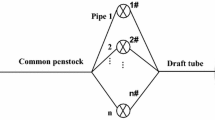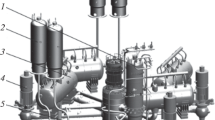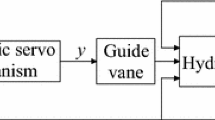Abstract
A nonlinear dynamic coupled model for hydropower station system, which contains the model of water-carriage system, water turbine system, speed governor system, generator’s electromagnetic system, grid, shaft system of hydroelectric generating set, as well as the powerhouse, is established in this paper. Firstly, the simultaneous differential equations for coupled hydraulic–mechanical–electric transient process are set up based upon the theories of hydraulics, electrical machinery, etc., while the coupled structural models for shaft system of unit and powerhouse are built by means of finite element method. Secondly, a new method for investigating nonlinear dynamic properties of structures influenced by coupled hydraulic–mechanical–electric factors in different conditions is introduced with the help of user-programmable features from Ansys software. Finally, in order to verify the rationality, several numerical calculation methods are used to study the starting-up process of hydropower station. The results indicate that the model presented in this paper is adoptable for simulating specified condition and reflect the nonlinear dynamic characteristics of hydropower station comprehensively. In addition, the model can also be used to assess the operation safety and predict the structures reliability of hydropower station system, so as to provide some profitable reference for dynamic regulation during limited and transient conditions for hydropower station.












Similar content being viewed by others
Abbreviations
- A :
-
Area of penstock
- a :
-
Water hammer wave velocity
- \(b_{\mathrm{p}}\) :
-
Permanent droop
- \(b_{\mathrm{t}}\) :
-
Temporary droop
- \(c_{\mathrm{b}}\) :
-
Clearance of bearing
- \(c_{ij}\) :
-
Damping cofficients, \(i=x, y\); \(j=x, y\)
- \(c_\mathrm{r}\) :
-
Air gap length of rotor
- D :
-
The cross section diameter of penstock
- \(D_{1}\) :
-
The diameter of water turbine
- \(E^\prime \) :
-
Transient electromotive force (EMF)
- \(e_{\mathrm{b}}\) :
-
Eccentricity of shaft axis
- \(e_{\mathrm{r}}\) :
-
Eccentricity of rotor center
- \(E_\mathrm{fd}\) :
-
Imaginary open-circuit EMF generated by field voltage
- \(E_\mathrm{q}\) :
-
No-load terminal EMF
- \({E_\mathrm{q}^{\prime }}\) :
-
Transient EMF of q-axis
- \(f_\mathrm{e}, f_\mathrm{m}\) :
-
Electric and mechanical frequency
- \(f_\mathrm{es}, f_\mathrm{ms}\) :
-
Electric and mechanical synchronous frequency
- h :
-
Thickness of oil film
- \(H_{i}\) :
-
Head in penstock at the node i
- \(H_{n}\) :
-
Net water head of water turbine
- \(I, I_\mathrm{d}, I_\mathrm{q}\) :
-
Stator current and corresponding d- and q-component
- \(I_\mathrm{f}\) :
-
Excitation current
- J :
-
Moment inertia of the hydroelectric generating set
- \(k_{ij}\) :
-
Stiffness coefficients, \(i=x, y\); \(j=x, y\)
- \(K_\mathrm{P}, K_\mathrm{I}, K_\mathrm{D}\) :
-
Proportional, integral and differential gain of governor
- \(L_\mathrm{p}\) :
-
Height of pad
- \(L_\mathrm{r}\) :
-
Length of rotor
- \(M_\mathrm{e}\) :
-
Electric torque
- \(M_\mathrm{t}\) :
-
Mechanical torque
- n :
-
Mechanical speed of water turbine
- \(n_\mathrm{s}\) :
-
Mechanical synchronous speed of water turbine
- \(n_{1}^\prime \) :
-
Unit mechanical speed of water turbine
- p :
-
Oil pressure
- \(P_\mathrm{e}\) :
-
Electric power (active output)
- \(P_\mathrm{t}\) :
-
Power of water turbine
- \(P_{1}^\prime \) :
-
Unit power of water turbine
- \(Q_{1}^\prime \) :
-
Unit discharge of water turbine
- \(Q_{i}\) :
-
Discharge in penstock at the node i
- \(R_\mathrm{a}\) :
-
Radius of shaft
- \(R_\mathrm{b}\) :
-
Radius of journal
- \(R_\mathrm{e}\) :
-
Resistance of transmission line
- \(R_\mathrm{i}\) :
-
Inner radius of pad
- \(R_\mathrm{L}\) :
-
Resistance of system load
- \(R_\mathrm{o}\) :
-
Outer radius of pad
- \(R_\mathrm{r}\) :
-
Radius of rotor
- \(T_\mathrm{d}\) :
-
Reset time or dashpot constant
- \(T_{d0}^\prime \) :
-
Open-circuit transient time constant of d-axis
- \(T_\mathrm{e}\) :
-
Time constant of excitation
- \(T_\mathrm{m}\) :
-
Water turbine inertia time constant
- \(T_\mathrm{n}\) :
-
Accelerating time constant
- \(T_\mathrm{w}\) :
-
Water inertia time constant
- \(T_\mathrm{y}\) :
-
Servomotor response time constant
- \(U_\mathrm{f}\) :
-
Excitation voltage
- \(U_\mathrm{L}\) :
-
Load voltage of system
- \(U_\mathrm{G}, U_\mathrm{Gd}, U_\mathrm{Gq}\) :
-
Stator terminal voltage and corresponding d- and q-component
- \(X_\mathrm{e}\) :
-
Reactance of transmission line
- \(X_\mathrm{L}\) :
-
Reactance of system load
- \(X_\mathrm{d}, X_\mathrm{q}\) :
-
Synchronous reactance of d-and q-component
- \(X^\prime _\mathrm{d}\) :
-
Transient reactance of d-component
- y :
-
Servomotor stroke of governor
- \(\alpha _\mathrm{p}\) :
-
Opening angle of pad
- \(\beta \) :
-
Angle between a point of support for pad and y-axis
- \(\Delta y\) :
-
Deviation value of water turbine servomotor stroke
- \(\delta \) :
-
Power angle
- \(\delta _\mathrm{p}\) :
-
Swing angle of pad
- \(\eta \) :
-
Efficiency of water turbine
- \(\eta _{l}\) :
-
Angle between the calculation location and y-axis
- \(\theta _\mathrm{b}\) :
-
Deviation angle of bearing axis
- \(\theta _\mathrm{e}, \theta _\mathrm{m}\) :
-
Electric and mechanical rotation angle
- \(\lambda \) :
-
Dimensionless coordinate of pad along the shaft
- \(\tau \) :
-
Guide vane opening
- \(\varphi \) :
-
Power factor
- \(\psi \) :
-
Inner power factor
- \(\omega _\mathrm{e}, \omega _\mathrm{m}\) :
-
Electric and mechanical speed
- \(\omega _\mathrm{es}, \omega _\mathrm{ms}\) :
-
Electric and mechanical synchronous speed
References
Chaudry, M.H.: Applied Hydraulic Transients. Springer, New York (2014)
Collatz, L.: The Numerical Treatment of Differential Equations. Springer, Berlin (1960)
Wylie, E.B., Streeter, V.L.: Fluid Transient in Systems. Prentice-Hall, Englewood Cliffs (1993)
Parmakian, J.: Water-Hammer Analysis. Prentice-Hall, Englewood Cliffs (1955)
Lighthill, J.: Waves in Fluids. Cambridge University Press, Oxford (1978)
Ghidaoui, M.S., Mansour, S.: Efficient treatment of the Vardy-Brown unsteady shear in pipe transients. J. Hydraul. Eng. ASCE 128(1), 102–112 (2002)
Silva-Araya, W.F., Chaudhry, M.H.: Unsteady friction in rough pipes. J. Hydraul. Eng. ASCE 127(7), 607–618 (2001)
Shuy, E.B.: Wall shear stress in accelerating and decelerating turbulent pipe flows. J. Hydraul. Res. 34(2), 173–183 (1996)
Yang, J.C., Hsu, E.L.: On the use of the reach-back characteristics method of calculation of dispersion. Int. J. Numer. Methods Fluids 12(3), 225–235 (1991)
Ruprecht, A., Helmrich, T.: Simulation of the water hammer in a hydro power plant caused by draft tube surge. In: 4th ASME/JSME Joint Fluids Engineering Conference. Honolulu (2003)
Panov, L.V., Chirkov, D.V., Cherny, S.G., et al.: Numerical simulation of pulsation processes in hydraulic turbine based on 3D model of cavitating flow. Thermophys. Aeromech. 21(1), 31–43 (2014)
Zhang, X.X., Cheng, Y.G.: Simulation of hydraulic transients in hydropower systems using the 1-D-3-D coupling approach. J. Hydrodyn. Ser. B. 24(4), 595–604 (2012)
Zhang, X.X., Cheng, Y.G., Yang, J.D., et al.: Simulation of the load rejection transient process of a Francis turbine by using a 1-D-3-D coupling approach. J. Hydrodyn. Ser. B. 26(5), 715–724 (2014)
IEEE Committee, : Dynamic models for steam and hydro turbines in power system studies. IEEE Trans. Power Appar. Syst. PAS-92(6), 1904–1915 (1973)
Oldenburge, R., Donelson, J.: Dynamic response of a hydroelectric plant. Trans. Am. Inst. Electr. Eng. Part 3 81(3), 403–418 (1962)
Hovey, L.M.: Optimum adjustment of hydro governors on Manitoba hydro system. Trans. Am. Inst. Electr. Eng. Part 3 81(3), 581–586 (1962)
Sanathanan, C.K.: Accurate low order model for hydraulic turbine-penstock. IEEE Trans. Energy Convers. EC–2(2), 196–200 (1987)
Vournas, C.D.: Second order hydraulic turbine models for multimachine stability studies. IEEE Trans. Energy Convers. 5(2), 239–244 (1990)
Paynter, H.M.: A Palimpsest on the Electronic Analog Art. A. Philbrick Researches Inc., Boston (1955)
Leum, M.: The development and field experience of a transistor electric governor for hydro turbines. IEEE Trans. Power Appar. Syst. PAS–85(4), 393–402 (1966)
Phi, D.T., Bourque, E.J., Thorne, D.H., et al.: Analysis and application of the stability limits of a hydro-generating unit. IEEE Trans. Power Appar. Syst. PAS–100(7), 3203–3212 (1981)
Hagihara, S., Yokota, H., Goda, K., et al.: Stability of a hydraulic turbine-generating unit controlled by PID governor. IEEE Trans. Power Appar. Syst. PAS–98(6), 2294–2298 (1979)
Murphy, L.D., Wozniak, L., Whittemore, T.A.: A digital governor for hydro generators. IEEE Trans. Energy Convers. 3(4), 780–784 (1989)
Anwar, M.N., Pan, S.: A new PID load frequency controller design method in frequency domain through direct synthesis approach. Int. J. Electr. Power Energy Syst. 67, 560–569 (2015)
Kamwa, I., Lefebvre, D., Loud, L.: Small Signal Analysis of Hydro-Turbine Governors in Large Interconnected Power Plants. IEEE Power Engineering Society Winter Meeting, New York (2002)
Wozniak, L., Filbert, T.L.: Speed loop cancellation governor for hydrogenerators—part I: development. IEEE Trans. Energy Convers. 3(1), 85–90 (1988)
Li, H., Chen, D., Zhang, H., et al.: Nonlinear modeling and dynamic analysis of a hydro-turbine governing system in the process of sudden load increase transient. Mech. Syst. Signal Process. 80, 414–428 (2016)
Zhang, H., Chen, D., Xu, B., et al.: Nonlinear modeling and dynamic analysis of hydro-turbine governing system in the process of load rejection transient. Energy Convers. Manag. 90, 128–137 (2015)
Xu, B., Wang, F., Chen, D., et al.: Hamiltonian modeling of multi-hydro-turbine governing systems with sharing common penstock and dynamic analyses under shock load. Energy Convers. Manag. 108, 478–487 (2016)
Kilgore, L.A.: Calculation of synchronous machine constants-reactances and time constants affecting transient characteristics. Trans. Am. Inst. Electr. Eng. 50(4), 1201–1213 (1931)
Wright, S.H.: Determination of synchronous machine constants by test reactances, resistances and time constants. Trans. Am. Inst. Electr. Eng. 50(4), 1331–1350 (1931)
Heffron, W.G., Phillips, R.A.: Effect of a modern amplidyne voltage regulator on underexcited operation of large turbine generators. IEEE Trans. Power Appar. Syst. 71(1), 692–697 (1952)
Sayidi, A.M., Nekoui, M.A., Boghrabidi, N.S.: Adaptive optimal control for a one-machine infinite-bus power system. In: International Conference on Computational Intelligence for Modeling Control and Automation, Vienna (2008)
Demello, F.P., Laskowski, T.F.: Concepts of power system dynamic stability. IEEE Trans. Power Appar. Syst. PAS–94(3), 827–833 (1975)
Demello, F.P., Concordia, C.: Concepts of synchronous machine stability as affected by excitation control. IEEE Trans. Power Appar. Syst. PAS–88(4), 316–329 (1969)
Zhong, Y.E., He, Y.Z., Wang, Z., et al.: Rotor Dynamics. Tsinghua University Press, Beijing (1987)
Wen, B.C., Gu, J.L., Xia, S.B., et al.: Senior Rotor Dynamics. China Machine Press, Beijing (2000)
Earles, L.L., Palazzolo, A.B., Armentrout, R.W.: A finite element approach to pad flexibility effects in tilt pad journal bearings: part 1—single pad analysis. J. Tribol. 112(2), 178–182 (1990)
Ma, Z.Y., Dong, Y.X.: Dynamic coefficients of tilting pad guide bearings of hydraulic turbine set. Power Eng. 10(6), 6–11 (1990)
Adiletta, G., Guido, A.R., Rossi, C.: Nonlinear dynamics of a rigid unbalanced rotor in journal bearings. Part I: theoretical analysis. Nonlinear Dyn. 14(1), 57–87 (1997)
Adiletta, G., Guido, A.R., Rossi, C.: Nonlinear dynamics of a rigid unbalanced rotor in journal bearings. Part II: Experimental analysis. Nonlinear Dyn. 14(2), 157–189 (1997)
Rho, B.H., Kim, K.W.: A study of the dynamic characteristics of synchronously controlled hydrodynamic journal bearings. Tribol. Int. 35(5), 339–345 (2002)
Tiwari, R., Lees, A.W., Friswell, M.I.: Identification of speed-dependent bearing parameters. J. Sound Vib. 254(5), 967–986 (2002)
Xu, Y., Li, Z.H., Lai, X.D.: Dynamic model for hydro-turbine generator units based on a database method for guide bearings. Shock Vib. 20(3), 411–421 (2013)
Zhang, L.K., Ma, Z.Y., Song, B.W.: Dynamic characteristics of a rub-impact rotor-bearing system for hydraulic generating set under unbalanced magnetic pull. Arch. Appl. Mech. 83(6), 817–830 (2013)
Zeng, Y., Zhang, L.X., Guo, Y.K., et al.: The generalized Hamiltonian model for the shafting transient analysis of the hydro turbine generating sets. Nonlinear Dyn. 76(4), 1921–1933 (2014)
Xu, B.B., Chen, D.Y., Zhang, H., et al.: Dynamic analysis and modeling of a novel fractional-order hydro-turbine-generator unit. Nonlinear Dyn. 81(3), 1263–1274 (2015)
Gustavsson, R.K., Aidanpää, J.O.: Evaluation of impact dynamics and contact forces in a hydropower rotor due to variations in damping and lateral fluid forces. Int. J. Mech. Sci. 51(9–10), 653–661 (2009)
Zhang, L.K., Ma, Z.Y., Wu, Q.Q., et al.: Vibration analysis of coupled bending-torsional rotor-bearing system for hydraulic generating set with rub-impact under electromagnetic excitation. Arch. Appl. Mech. (2016). doi:10.1007/s00419-016-1142-8
Xu, W., Ma, Z.Y., Zhi, B.P.: Analysis on power flow transmission of pressure fluctuation along the walls of hydropower house. J. Hydroelectr. Eng. 32(2), 233–239 (2013)
Zhang, Y.L., Ma, Z.Y., Chen, G.R., et al.: Strength and stiffness analysis of spiral casing with different embedded manners. J. Hydraul. Eng. 37(10), 1206–1211 (2006)
Zhang, C.H., Ma, Z.Y., Zhou, S.D., et al.: Analysis of fluid–solid interaction vibration characteristics of large-scale hydropower house. J. Hydroelectr. Eng. 31(6), 192–197 (2012)
Sun, W.Q., Huang, X.H.: Identification of vibration transfer path for the coupled system of water turbine generator set and power house. J. Vib. Shock. 33(6), 23–28 (2014)
Song, Z.Q.: Research on Coupling Vibration Characteristics of Generator Set and Hydropower House. Dalian University of Technology, Dalian (2009)
Yang, X.M.: Research on Generating Set Vibration and Coupled that and Hydropower House Vibration in Hydropower Station. Dalian University of Technology, Dalian (2006)
Chen, Z., Chen, S.S., Zhang, Z.H., et al.: Effect of hydraulic system models on power system transient stability analysis. J. Tsinghua Univ. Sci. Technol. 36(7), 13–18 (1996)
Chen, Z., Diao, Q.H., Chen, S.S., et al.: Study on the effect of hydraulic system models on power system dynamic stability analysis. J. Tsinghua Univ. Sci. Technol. 36(7), 69–74 (1996)
Zhao, G.L.: Study on the United Transient Process for Hydraulic Mechanical and Power System. Wuhan University, Wuhan (2004)
Guo, W.C., Yang, J.D., Yang, W.J., et al.: Regulation quality for frequency response of turbine regulating system of isolated hydroelectric power plant with surge tank. Int. J. Electr. Power Energy Syst. 73, 528–538 (2015)
Fang, H.Q., Chen, L., Dlakavu, N., et al.: Basic modeling and simulation tool for analysis of hydraulic transients in hydroelectric power plants. IEEE Trans. Energy Convers. 23(3), 834–841 (2008)
Committee, I.E.E.E.: Hydraulic-turbine and turbine control-models for system dynamic studies. IEEE Trans. Power Syst. 7(1), 167–179 (1992)
Bao, H.Y., Yang, J.D., Fu, L.: Study on nonlinear dynamical model and control strategy of transient process in hydropower station with Francis turbine. In: Asia-Pacific Power and Energy Engineering Conference, Wuhan (2009)
Acknowledgments
This research is supported by the National Natural Science Foundation of China (No.51379030) and Youth Foundation of Taiyuan University of Technology (No. 2015QN029).
Author information
Authors and Affiliations
Corresponding author
Rights and permissions
About this article
Cite this article
Wu, Q., Zhang, L. & Ma, Z. A model establishment and numerical simulation of dynamic coupled hydraulic–mechanical–electric–structural system for hydropower station. Nonlinear Dyn 87, 459–474 (2017). https://doi.org/10.1007/s11071-016-3053-1
Received:
Accepted:
Published:
Issue Date:
DOI: https://doi.org/10.1007/s11071-016-3053-1




